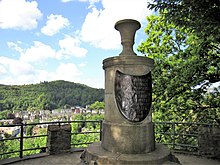Wilhelm Tappe
Wilhelm Tappe (* 1769 in Lüdenscheid ; † 1823 ) was a Westphalian drawing teacher, graphic artist , master builder , architectural theorist and poet. He was the author of one of the first German art histories.
From 1810 to 1813 he worked as a builder in Hagen. He was then appointed by Princess Pauline to be the master builder of Lippe and held this office in Detmold from 1813 to 1819 .
Between 1818 and 1823 he propagated a hemispherical type of building in clay construction in eight writings. He called his shape the "elliptical arc style" and explained: "The organic life works in the round building" . A prototype in Hiddesen had to be broken off again in 1823 due to insufficient insulation against moisture. His other structures built in this way also did not last. What has been preserved, however, are the renovation work on the Hemer and the monuments erected according to his designs for the Elsey preacher Johann Friedrich Möller , which were inaugurated in Hohenlimburg in 1814 and 1816 .
In 1820 he published the results of his mapping of burial mounds in Paderborn and Lippe and achieved the protection of the graves. Tappe drew up a design from 1823 for a Hermann monument above a gate with arched shapes.
Tappe also tried his hand at other areas outside of construction. According to his suggestions, drawing lessons were introduced in the higher middle schools in the county of Mark and the Prussian budget and war minister Friedrich Anton von Heynitz (1725–1802) became aware of him. Tappe also campaigned for the Lüdenscheid industry. With the help of his relatives, he set up a production of sample cards for the local button industry. He also worked as an advertising specialist. In doing so, he made great contributions to the Lüdenscheid button industry, which developed strongly through his commitment.
supporting documents
- ↑ Hubertus Schwartz: The street names of the city of Soest, status April 1, 1966. Soest 1966, p. 57.
Works
- The mine trip: portrayed poetically. Schwelm 1809 ( LLB Detmold )
- General first exercises in free drawing. Duisburg approx. 1812 ( LLB Detmold )
- The antiquities of German architecture in Soest. Baedecker, Essen 1823
literature
- Ludwig Schreiner: Wilhelm Tappe (1769–1823), an architectural theorist of the 19th century . In: Low German contributions to art history . Volume 9, 1970, pp. 195-234.
Web links
| personal data | |
|---|---|
| SURNAME | Tap, Wilhelm |
| BRIEF DESCRIPTION | German master builder |
| DATE OF BIRTH | 1769 |
| PLACE OF BIRTH | Ludenscheid |
| DATE OF DEATH | 1823 |

